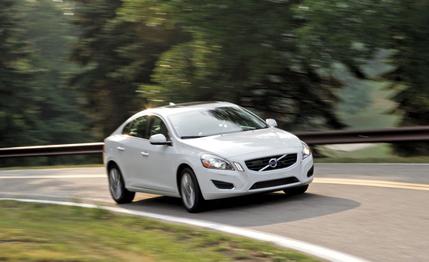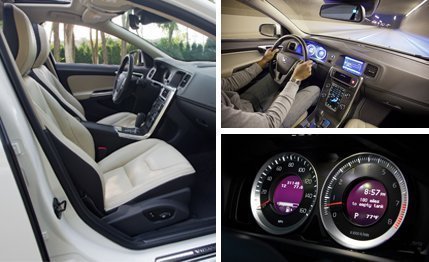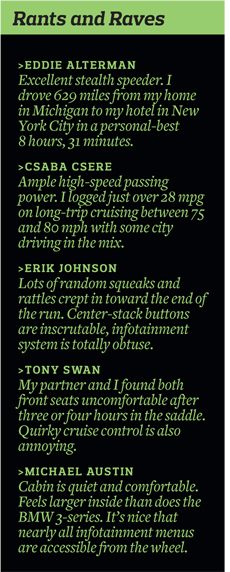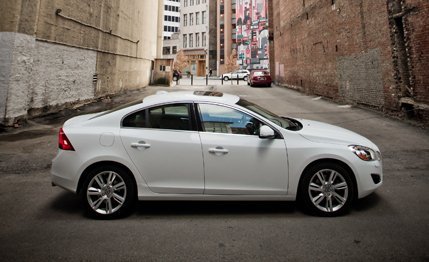
 Long-Term Road Test Wrap-Up
Long-Term Road Test Wrap-Up


This test did not begin well. Our barely broken-in long-term Volvo S60 T6 acquired an illness that our local dealer couldn’t diagnose, let alone fix. It came on with a warning light reporting blockage of the windshield wipers’ rain sensors. As our driver slowed to investigate, the entire cluster went Vegas and the engine shut down. Following a nervous traffic-clotting pause and a full reboot, our S60 fired back up with its check-engine lamp glowing.
The car was diagnosed as having a faulty steering-pump module due to moisture that was causing a CAN disruption. (CAN stands for Controller Area Network, the party line linking all of the car’s computer modules.) Following the warranty replacement of its power-steering fluid, pump, and electronic control module, our Volvo resumed its long-term test.
Five weeks later, the gremlin returned. After suffering several more surprise shutdowns, we revisited the dealer. Two weeks of testing with the aid of a factory technician failed to pinpoint the problem, so our test car was summoned to Volvo’s North American headquarters in Rockleigh, New Jersey. After a month of consultations with engineers in Sweden, the service experts finally aborted their search for the electrical fault, which could have been a microscopic flaw inside a module. The automotive equivalent of radical surgery was prescribed: replacement of five modules and most of the wiring harness. Several hundred miles of test driving confirmed that this procedure was successful.


Both before and after the debilitating electrical infarction, our S60 logbook entries ran strongly positive as the car ticked off all points of the compass—west to South Dakota, south to the Carolinas, east to New York, and to the northern limits of Michigan’s lower peninsula. Several editors lauded this Volvo’s intelligent balance between interior space and exterior bulk. It provides ample elbowroom for five, a 12-cubic-foot trunk, and rear seats that split and fold to stretch the cabin’s versatility. Consistent with its Swedish breeding, the S60 is tastefully attractive without feeling too tightly laced. Its balanced proportions, flowing roofline, and diagonal grille sash provide a pleasant break from the compact-sports-sedan segment’s German standard.
Inside, smartly sculpted and trimmed surfaces set a mood that’s more relaxing than that in comparable Audi, BMW, or Mercedes sedans. The front seats offer easy entry and comfortable support, though gripes also infiltrated the logbook: headrests tilt a bit too far forward, not enough lateral support to brace thighs during aggressive cornering. The S60 is more a cruiser than a charger so no paddle shifters are provided. While the console lever offers a manual mode, the six-speed transmission is programmed to execute automatic upshifts slightly before the 6600-rpm redline. At least the three-spoke wheel is nicely notched and clad, plus there’s a perfectly configured dead pedal. In contrast to the large, anthropomorphic buttons that direct the climate-control system’s airflow, many of the steering-wheel and center-stack switches are small and confusingly labeled. Seemingly simple tasks—tuning the radio, regulating cabin temperature—occasionally caused consternation.


Every critic loved the Porsche-developed 3.0-liter turbo six for its smooth, lag-free response and the effortless way it hurls this 3885-pound sedan through traffic, albeit with a wild-howl accompaniment above 6000 rpm. We clocked an initial performance of 6.0 seconds on the run to 60 mph and 14.5 seconds at 98 mph in the quarter-mile, sufficient hustle to run with the turbo-four Audi, BMW, and Mercedes entry-lux crowd. At 40,000 miles, when this S60 was nicely loosened up, it was significantly quicker: The 5.5 seconds we measured during the 0-to-60-mph sprint and 14 seconds flat at 102 mph in the quarter-mile are just a touch slower than a stick-shift BMW 335i.
Our S60 also earned praise for gliding along at speed without commanding attention. Rendered in white, this car suggests an earnest physician late for surgery rather than some reprobate on a thrill ride. Volvo’s Haldex all-wheel-drive system (standard in a T6) delivers most of the powertrain’s torque to the front wheels and a regulated portion to the rear axle, bolstering confidence on wet or slippery surfaces. While we had hopes of hammering through drifts and slaloming through winter traffic in this Volvo, Michigan weather was unusually warm and dry while the S60 was in our fleet, scotching that opportunity.


In contrast to BMW, Volvo crams its six cylinders in a row sideways under the hood, adding a bevel gear in the transaxle to send torque rearward. This arrangement restricts steering lock and results in a cumbersome turning circle: The S60 needs 39 feet to complete a U-turn between curbs, only eight inches less than a full-size Chevy pickup. Another issue with a large-displacement engine in the nose is poor weight distribution. Because the front tires bear more than 60 percent of the total car mass, understeer kicks in early and forcefully. Worse yet, the stability system offers unwanted assistance as soon as the front end slides. The hard cornering fun is capped at 0.88 g on fresh tires and with stability control turned off.
While sports-sedan makers generally attach their front crossmembers rigidly to the unibody to sharpen steering feel and feedback, Volvo dissents with rubber mounting up front. Unfortunately, this doesn’t necessarily pay off with a superior ride; there were logbook complaints concerning impact harshness, head toss, and too-aggressive damping over rough pavement. Nor is the extra rubber beneficial to steering feel and feedback, which we also found lacking. The only solace is the readily adjustable steering effort provided by the S60’s My Car personalization menu.
Volvo takes pride in promoting advanced safety technology and bundles several such systems for the S60 in a $2100 Technology package. Included are more forward-looking antennae than you’d find at Ice Station Zebra built into the grille and upper windshield, plus lots of switches sprinkled throughout the interior. Some of this gear is handy and easy to operate, some isn’t.
If you wander from a dead-straight path without a turn signal activated, the lane-departure system whinnies annoyingly; it prompted one reviewer to check mirrors for the Lone Ranger. Others praised the system’s restraint in not sounding the alarm until the car reaches the very fringes of the lane.
Thankfully, we had no opportunity to exercise this Volvo’s collision-warning and pedestrian-detection systems, both of which have the authority to slam on full braking in desperate moments. But these sensors frequently trigger false radar-detector alarms.


Few drivers loved the adaptive cruise-control system. Most found headache-inducing the six steering-wheel buttons that command it, the four icons at the center of the speedometer display that tell you what’s what, and the 10 pages of instructions in the owner’s manual. Former EIC Csaba Csere characterized this system as “one of the most loathsome driving aids on the market,” because of the distracting, heavy-handed, and overly conservative way it trims speed and stretches the gap to the car ahead, practically begging other cars to seize your spot in the flow. A more tolerant driver relied on this equipment to endure 20 miles of stop-and-go construction-zone traffic without once touching the gas or brake. Another user was frustrated by the need to engage an active mode to change the set speed in increments smaller than 5 mph.
By the time 40,000 miles registered on the S60’s odometer, it had redeemed itself from a reliability standpoint, requiring only five stops for scheduled service (every 7500 miles at no cost) plus a sixth dealer visit to investigate a high-speed braking vibration and a slight pull to the left. Fresh brake rotors installed under warranty fixed the tremors and a $90 front-end alignment restored the S60’s sense of direction.
We waved goodbye to our S60 with mixed emotions. We’ll miss its willingness to whiz across whole states in a single stint. The overload of well-meaning but not necessarily helpful electronic gear, well, that we can live without. This test’s most vivid experience was the effort expended by the factory and our local dealer to rectify what we regard as a freak failure. We can only hope that every Volvo customer receives similar treatment if the need arises.